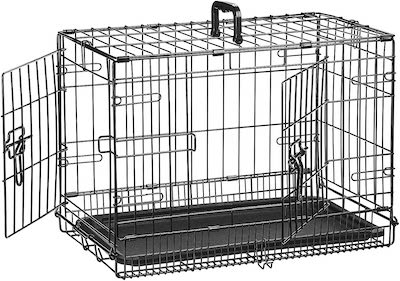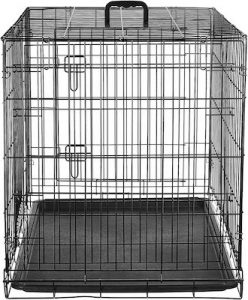Using crates is a fantastic way to housebreak and provide a safe and comfy place for your dog to relax. I’m not sure if you have read it, but I have a marvellous guide on the best dog crates you can buy in the UK.
But that won’t help much if you’re unsure about the right dimensions. So, today, I’ll help you measure your dog and choose the ideal dog crate size.
Choosing the right crate size for your pup is not just a matter of aesthetics; it directly impacts their well-being and happiness.
Let me explain.
Why does crate size matter so much?
For adult dogs who have been housebroken and the crate stays in the house, perhaps not. But it most certainly does for puppies and dogs, not potty trained. And I can attest to this, having crate-trained Jeff at an early age.
Generally speaking, dog crate size directly impacts your dog’s comfort, safety, and overall well-being. Dogs naturally seek secure and snug spaces, akin to dens, where they can rest peacefully. Providing them with a properly sized crate offers that sense of security, reducing anxiety and stress.
On the other paw, using the wrong crate size can lead to potential issues. A crate that is too small may cause discomfort and restrict movement, leading to restlessness and frustration. In contrast, an excessively large crate may prompt unwanted behaviours, such as soiling the crate or using one end as a designated bathroom.
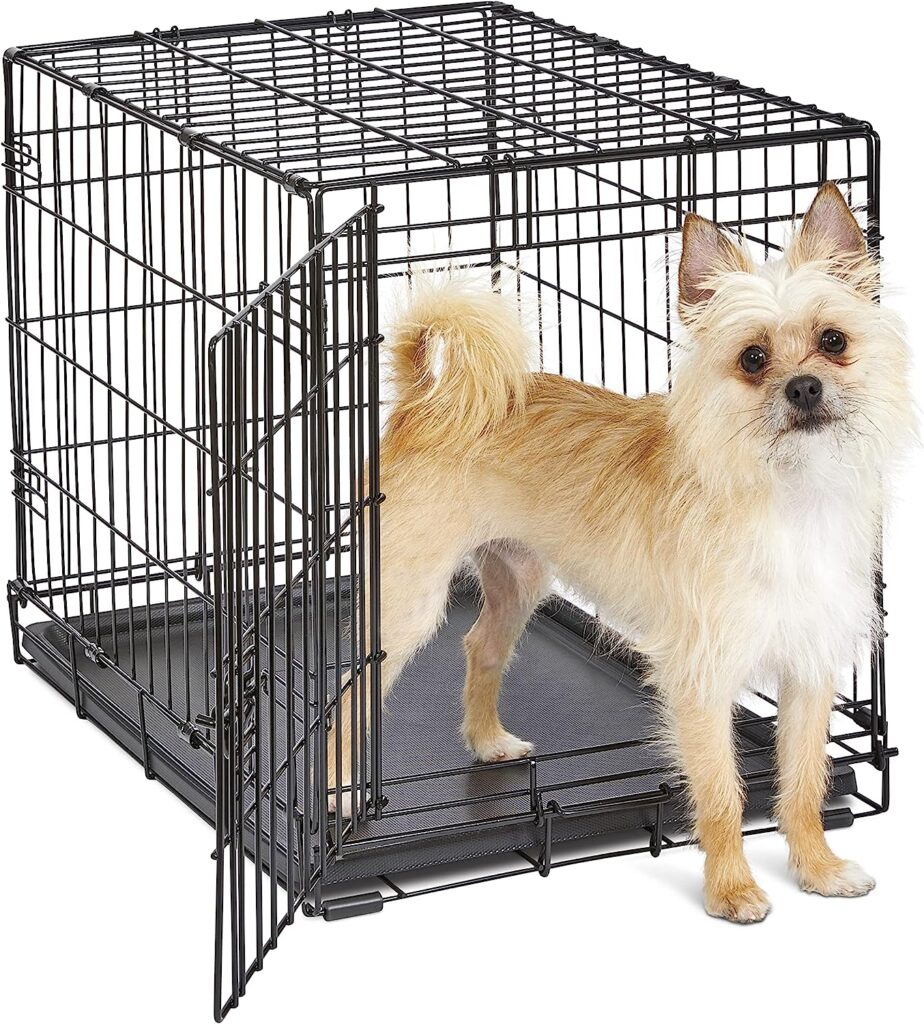
How to measure your dog for the right crate size?
Determining the correct crate size for your dog is a paw-sitively crucial step in providing them with a cosy and secure space. Pardon the pun.
Step 1: Measure Length and Height.
Start by having your dog stand up straight and measure their length from the tip of their nose to the base of their tail. Next, measure their height from the floor to the tallest point of their shoulders or head, depending on their posture.
Step 2: Add Extra Inches for Comfort.
Now that we have the length and height measurements adding extra wiggle room is time. Add approximately 2 to 4 inches in length and height so your dog has ample room.
Step 3: Consider Your Dog’s Breed and Age.
Make the final adjustments based on your dog’s breed. Smaller breeds may require a more compact space, while larger breeds might appreciate more room to spread out. Puppies will grow, so you must consider that too.
By following these simple steps, you’ll be well on your way to finding the ideal crate size.
If you still need answers, such as which crate type to choose between wire, plastic and soft-sided, you can refer to my buyer’s guide:
Read More: Buyer’s Guide: How to choose the best dog crate?
Dog Crate Size & Weight Chart for Most Common UK Breeds
Now you’re equipped to correctly measure your doggo. And that means the problem we must tackle is how to use those measurements to find the ideal crate for housebreaking.
If the crate is too big, your dog will soil in excess space. But if it’s aptly sized, dogs are more likely to not soil their bed and hold it in to do it elsewhere. So, for a casual size guide, you should aim for a crate that is big enough for them to get up and turn around and nothing more.
To make it easier, here’s a generic list of crate sizes and what breeds they are most suitable for:
| Dog Crate Sizes | Length of Crate (cm) | Max. Dog Height (cm) | Max. Dog Length (cm) | Dog Weight (kg) | Common Breeds |
| XS Dog Crate | 48 | 30 | 43 | < 9 | Chihuahua, Maltese, Pomeranian |
| S Dog Crate | 61 | 46 | 56 | 9-13 | Jack Russell Terrier, Miniature Poodle |
| M Dog Crate | 76 | 46 | 71 | 13-18 | Cocker Spaniel, French Bulldog, Pit Bull Terrier |
| L Dog Crate | 91 | 58 | 86 | 18-32 | Beagle, Bulldog, English Setter |
| XL Dog Crate | 107 | 71 | 102 | 32-41 | Labrador, Golden Retriever, Boxer |
| 2XL Dog Crate | 122 | 76 | 117 | 41+ | Rottweiler, Bernese Mountain Dog, Great Dane |
Pro Tip:
Most crates on the market will do, but you’ll need to make sure to buy a divider from the same brand to make sure there aren’t any niggling installation issues. I’d recommend looking at the Elli-Bo brand I used for Jeff.
Some of these may not be suitable if you’re looking for travel crates. Don’t worry, though; we’ll be discussing that next.
Travel Dog Crates: How to choose the ideal size?
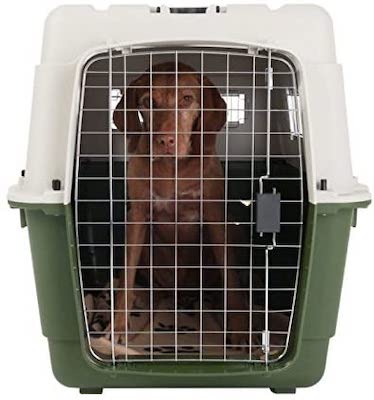
A dog travel crate becomes an invaluable tool in your arsenal when it comes to travelling. Unlike standard home crates, travel crates are designed for portability and convenience.
They’re usually crafted from a collapsible metal frame and durable fabric material, providing a snug and secure space for your dog during journeys. Whether heading to the vet, visiting friends, or enjoying a staycation, a travel crate offers a cosy spot for your dog.
Pro Tip: The ideal travel crate should be at least 15cm longer than your dog’s body length (from head to start of the tail) and at least 15cm higher than their shoulder height.
To help you make the best choice for your dog’s travel crate, we’ve prepared a table with size recommendations for common breeds:
| Travel Crate Length | Suitable Breeds |
| 46cm (18”) | Toy Breeds, Small Breed Puppies |
| 61cm (24”) | Chihuahua, Miniature Dachshund |
| 76cm (30”) | Westie, Beagle, French Bulldog |
| 91cm (36”) | Cockapoo, Springer Spaniel, Bulldog |
| 106cm (42”) | Labrador, Dalmatian, German Pointer |
| 121cm (48”) | German Shepherd, Bullmastiff |
These are general breed size recommendations, and individual dogs may vary. Consult your breeder or measure your dog to find the most suitable crate size.
Common Crate Size Mistakes to Avoid
Dog owners often make some common mistakes when choosing a crate. I have listed some of them here so you don’t repeat any.
- Make sure the crate is neither too big nor too small.
- For puppies, it’s essential to consider their future growth.
- Don’t forget to consider your dog’s opinions. Some dogs prefer a more enclosed and cosy space, while others enjoy openness.
- Safety is very important. Ensure the crate is well-padded with soft bedding for a cosy resting place.
Read More: How to help your dog cry less in its crate?
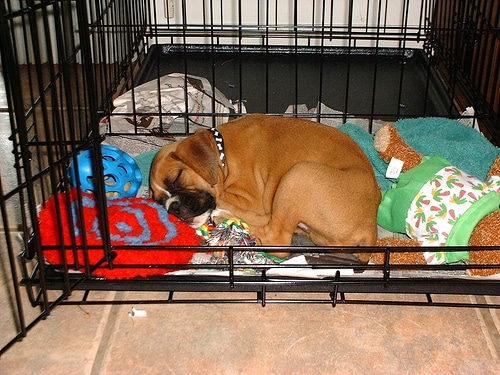
How to adjust crate size for puppies and growing dogs?
As your puppy grows and matures, their crate needs may change. It’s essential to adjust the crate size to accommodate their increasing size.
1. Using Dividers for Puppies
For young puppies, start with a crate size suitable for their average breed size, and use dividers to create a smaller space within the crate. This partition prevents your puppy from having excessive room, promoting successful crate training.
As your puppy grows, gradually adjust the divider to provide more space while ensuring it remains cosy and not too spacious.
2. Monitoring Your Dog’s Behavior
If you notice signs of discomfort or restlessness, it may indicate that they need a larger crate. On the contrary, if your puppy seems anxious or has potty accidents, the crate might be too big, and you should readjust the divider accordingly.
3. Gradually Transitioning to a Larger Crate
As your puppy reaches adulthood, it’s time to transition to a larger crate that suits its full-grown dimensions. Gradually introduce them to the new crate, ensuring it feels familiar and comfortable.
During this transition period, maintain a positive association with the crate through rewards and praise.
4. Choosing a Crate for Growing Dogs:
When getting a crate for an older dog still growing, consider selecting one that will accommodate their future adult size. Adjustable crates with dividers are an excellent choice for such scenarios, allowing you to adapt the crate as your dog grows.
